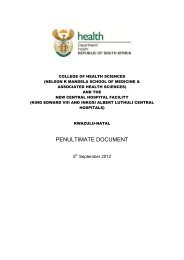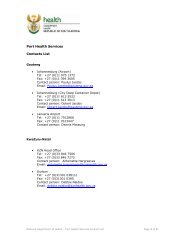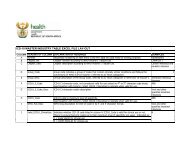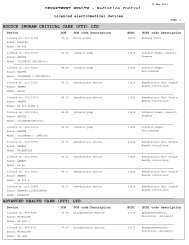National Norms and Standards relating to Environmental Health
National Norms and Standards relating to Environmental Health
National Norms and Standards relating to Environmental Health
You also want an ePaper? Increase the reach of your titles
YUMPU automatically turns print PDFs into web optimized ePapers that Google loves.
1. Proper methods of sampling must be applied <strong>and</strong> proper equipment utilized when taking watersamples, <strong>to</strong> prevent contamination of the samples <strong>and</strong> ensure credible water quality results afteranalysis.2. For microbiological water sampling at point of use, including (lakes, streams, rivers <strong>and</strong> dams) thefollowing equipment is applicable;• Sterile sample bottles;• Sealed container or cooler box <strong>and</strong> ice <strong>to</strong> keep the samples cooled;• A map showing sampling locations must be included when gathering sampling equipment;• A gas burner;• Field notebook / data sheet(s); <strong>and</strong>• Latex gloves <strong>to</strong> prevent contamination of samples by h<strong>and</strong>s.3. For microbiological sampling at the treatment works, the following equipment is applicable;• Clean labora<strong>to</strong>ry glass beaker or any well cleaned container large enough in volume for theprobes of the instruments <strong>to</strong> be lowered in (at least 250ml in volume);• Electrical conductivity meter;• PH field instrument;• Nephelometric turbidity meter (if required) or Secchi disk;• Temperature meter - electronic or field thermometer (if required);• Distilled water for cleaning the probes;• Field notebook / data sheet(s); <strong>and</strong>• Instrument for free available chlorine measurements.• A map showing sampling locations must be included when gathering sampling equipment.4. For chemical water samples, the following equipment is applicable• Correct clean sample bottles;• Cool boxWATER SAMPLING METHODSa) Procedural considerations in sampling1. When taking water samples, microbiological samples should be collected first <strong>to</strong> minimizecontamination;2. If the water sample contains residual chlorine, 1ml of a 10% sodium thiosulphate solution must beadded for every liter of sample taken pre-sterilised 500ml plastic containers prepared with a freezedriedconcentration of sodium thiosulphate must be used;3. Sampling bottles must be kept closed <strong>and</strong> clean until sampling / water collection;4. Sample bottles must not be rinsed with water before sampling.5. Field sampling equipment must be cleaned <strong>and</strong> calibrated before taking readings;6. Equipment must be calibrated taking cognisance of optimum conditions <strong>to</strong> calibrate equipment (i.e.calibration of pH meters <strong>to</strong> be done at 25ºC);7. Sampling bottles must not be left uncovered in the sun.8. Two separate samples will be required for chemical <strong>and</strong> microbiological samples <strong>and</strong> these must bekept separate at all times.9. Caution must be taken <strong>to</strong> consult with labora<strong>to</strong>ries with regards <strong>to</strong> equipment <strong>and</strong> procedures, timesfor delivering of samples, preservation methods for samples, prior <strong>to</strong> submission of samples foranalysis.10. All samples for microbiological analysis should be transported <strong>to</strong> the labora<strong>to</strong>ry within the period of 6hours after sampling.b) Techniques in samplingSampling at point of useNB: flaming of the tap should not be done if the objective of the sampling is <strong>to</strong> determine thequality of water that the community accesses at the point of use.Step 1: The cap must be removed from the sample bottle; care should be taken not <strong>to</strong> contaminate theinner surface of the cap <strong>and</strong> neck of the sample bottle with h<strong>and</strong>s;DOH. <strong>Norms</strong> <strong>and</strong> st<strong>and</strong>ards for environmental health in South Africa Feb 2013 98


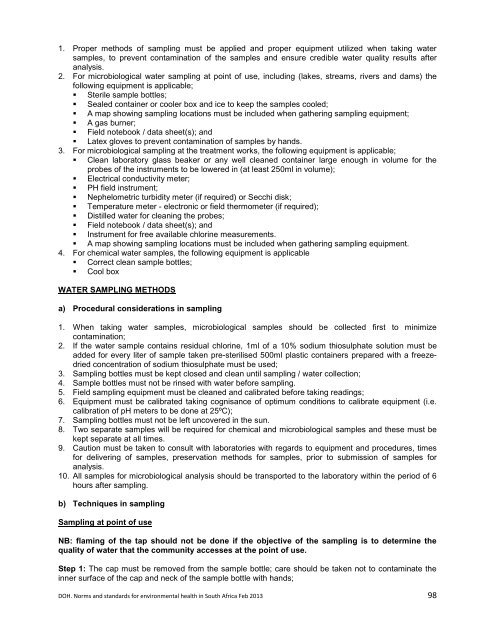
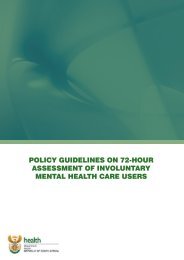
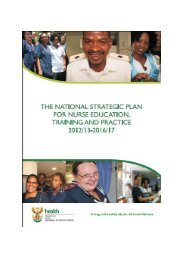
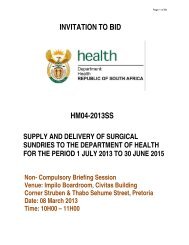
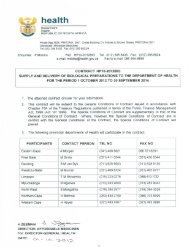
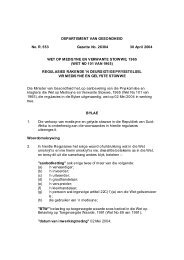
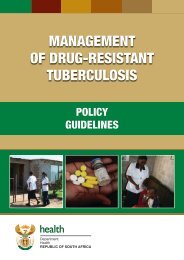
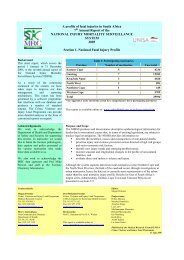
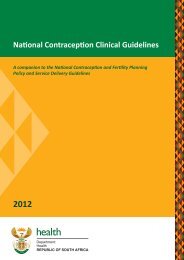
![A monograph of the management of postpartum haemorrhage [2011]](https://img.yumpu.com/15578784/1/184x260/a-monograph-of-the-management-of-postpartum-haemorrhage-2011.jpg?quality=85)
